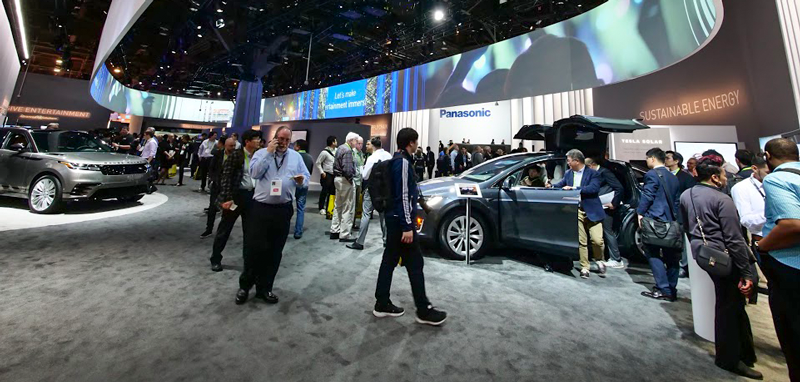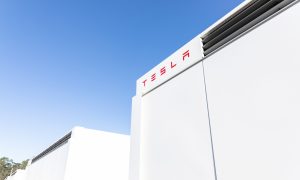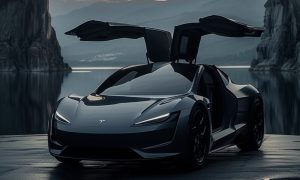Panasonic, the Japanese electronics giant, has supported Tesla since its early days in 2007. By 2010, Panasonic invested $30 million for a multi-year collaboration with Tesla developing lithium-ion battery cells for its electric vehicles. More recently, Panasonic announced Gigafactory partnerships with Tesla (in both Nevada and New York) to help produce batteries and solar products.
 |
Above: Tesla’s Model X is prominently showcased at Panasonic’s booth for this year’s Consumer Electronics Show (Source: Panasonic)
Panasonic doesn’t often comment on its alliance with Tesla. That said, the company revealed a bit more about their collaboration with Tesla at this year’s Consumer Electronics Show (via InsideEVs). And since the companies work together so closely, it’s conceivable that some of Panasonic’s prototype car tech could also foreshadow what’s coming inside of Tesla’s future vehicles. In any event, let’s take a look at what Panasonic revealed at CES this year…
Panasonic’s 2170 lithium-ion battery cells for Tesla
It’s reported that “Panasonic’s lithium-ion battery factory within Tesla’s Gigafactory handles production of 2170-size*1 cylindrical battery cells for Tesla’s energy storage system and its new Model 3 sedan, which began production in July 2017. The high performance cylindrical ‘2170 cell’ was jointly designed and engineered by Tesla and Panasonic to offer the best performance at the lowest production cost in an optimal form factor for both electric vehicles (EVs) and energy products.“
https://www.youtube.com/watch?v=JZjyNVhQPEQ
Above: A look at Pansonic’s 2170 lithium-ion batteries (Youtube: Panasonic Newsroom)
Panasonic’s solar products for Tesla
In addition to batteries, “Panasonic also collaborates with the company [Tesla] in the solar cell business and will begin production of solar cells this summer at its Buffalo, New York, factory. Solar cells produced at this factory are supplied to Tesla. In addition, the solar cells are used in roof tiles sold by Tesla, a product that integrates solar cells with roofing materials. Panasonic will continue its investment in the factory going forward and plans to raise solar cell production capacity to 1 GW by 2019.”
https://www.youtube.com/watch?v=nQaErKsNMNM
Above: More insight into Pansonic’s solar panels and solar roof tiles being produced at Tesla Gigafactory 2 in Buffalo, NY (Youtube: Panasonic Newsroom)
Autonomous Living Space Cabin
Upon reaching Level 5 self-driving capabilities, Panasonic explains tha “The future of mobility lies in fully-autonomous ‘Living Space’ vehicles, where the very act of driving recedes into the background. Travel time [instead] becomes live-your-life time. The car will be transformed into adaptive spaces that meet our needs: a mobile living room, a relaxation zone, and entertainment center—even an office on wheels.” Could Tesla’s car interiors look something like this in the future?
https://www.youtube.com/watch?v=itvfW0U_T5w
Above: How driverless cars could look in the future (Youtube: Panasonic Newsroom)
Scalable e-Powertrain Platforms for EV Bikes and Micro EVs
What if Tesla launches e-bikes and/or smaller electric cars? It’s reported that “The platform Panasonic has developed for EV bikes and micro EVs is an energy-efficient, safe powertrain that features integrated compactness, high efficiency, and flexible scalability. It consists of basic units, including a power unit (with an onboard charger, junction box, inverter and DC-to-DC converter) and a motor unit. The platform will help reduce costs and lead time for vehicle development.”
https://www.youtube.com/watch?v=Jxc7RHdsTko
Above: Panasonic’s scalable “ePowertrain” platform for e-bikes and smaller EVs (Youtube: Panasonic Newsroom)
Moving forward, Panasonic forecasts a strong partnership with Tesla cementing its place in the electric vehicle movement. The company notes, “Panasonic and Tesla are conducting phased investment in the Gigafactory… [and] Panasonic is estimating that global production volume for electric vehicles in fiscal 2026 will see an approximately six-fold increase from fiscal 2017 to over 3 million units. The company will contribute to the realization of a sustainable energy society through the provision of electric vehicle batteries.”
===
Note: Article originally published on evannex.com, by Matt Pressman
Source: InsideEVs / Panasonic Newsroom
Energy
Tesla Lathrop Megafactory celebrates massive Megapack battery milestone
The Tesla Megapack is the backbone of Tesla Energy’s battery deployments.
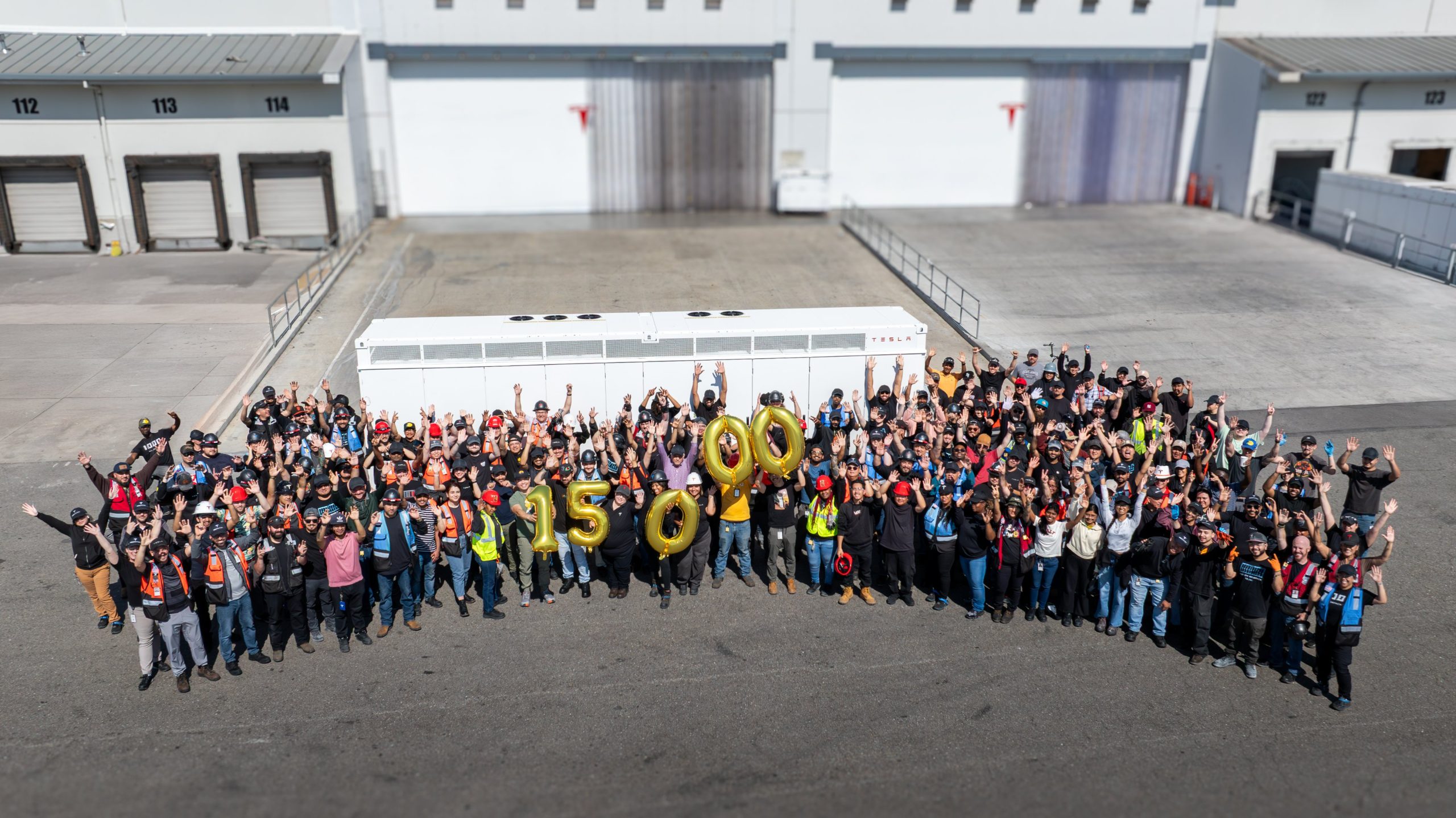
The Tesla Lathrop Megafactory recently achieved a new milestone. As per the official Tesla Megapack account on X, the Lathrop Megafactory has produced its 15,000th Megapack 2 XL battery.
15,000 Megapack Batteries
Tesla celebrated the milestone with a photo of the Lathrop Megafactory team posing with a freshly produced Megapack battery. To commemorate the event, the team held balloons that spelled out “15,000” as they posed for the photo.
The Tesla Megapack is the backbone of Tesla Energy’s battery deployments. Designed for grid-scale applications, each Megapack offers 3.9 MWh of energy and 1.9 MW of power. The battery is extremely scalable, making it perfect for massive energy storage projects.
More Megafactories
The Lathrop Megafactory is Tesla’s first dedicated facility for its flagship battery storage system. It currently stands as the largest utility-scale battery factory in North America. The facility is capable of producing 10,000 Megapack batteries every year, equal to 40 GWh of clean energy storage.
Thanks to the success of the Megapack, Tesla has expanded its energy business by building and launching the Shanghai Megafactory, which is also expected to produce 40 GWh of energy storage per year. The ramp of the Shanghai Megafactory is quite impressive, with Tesla noting in its Q1 2025 Update Letter that the Shanghai Megafactory managed to produce over 100 Megapack batteries in the first quarter alone.
Tesla Energy’s Potential
During the first quarter earnings call, CEO Elon Musk stated that the Megapack is extremely valuable to the energy industry.
“The Megapack enables utility companies to output far more total energy than would otherwise be the case… This is a massive unlock on total energy output of any given grid over the course of a year. And utility companies are beginning to realize this and are buying in our Megapacks at scale,” Musk said.
Energy
Tesla Megapacks powers the xAI Colossus supercomputer
Tesla Megapacks step in to stabilize xAI’s Colossus supercomputer, replacing natural gas turbines. Musk’s ventures keep intertwining.

Tesla Megapack batteries will power the xAI Colossus supercomputer in Memphis to ensure power stability. The collaboration between Tesla and xAI highlights the synergy among Elon Musk’s ventures.
The artificial intelligence startup has integrated Tesla Megapacks to manage outages and demand surges, bolstering the facility’s reliability. The Greater Memphis Chamber announced that Colossus, recently connected to a new 150-megawatt electric substation, is completing its first construction phase. This transition addresses criticism from environmental justice groups over the initial use of natural gas turbines.
“The temporary natural gas turbines that were being used to power the Phase I GPUs prior to grid connection are now being demobilized and will be removed from the site over the next two months.
“About half of the operating turbines will remain operating to power Phase II GPUs of xAI until a second substation (#22) already in construction is completed and connected to the electric grid, which is planned for the Fall of 2025, at which time the remaining turbines will be relegated to a backup power role,” the Chamber stated.
xAI’s rapid development of Colossus reflects its ambition to advance AI capabilities, but the project has faced scrutiny for environmental impacts. The shift to Megapacks and grid power aims to mitigate these concerns while ensuring operational continuity.
The Megapack deployment underscores the collaboration among Musk’s companies, including Tesla, SpaceX, Neuralink, and The Boring Company. Tesla appears to be the common link between all of Musk’s companies. For example, The Boring Company built a tunnel in Giga, Texas. In addition, Musk has hinted at a potential collaboration between the Tesla Optimus Bot and Neuralink. And from January 2024 to February 2025, xAI invested $230 million in Megapacks, per a Tesla filing.
Tesla Energy reported a 156% year-over-year increase in Q1 2025, deploying 10.4 GWh of storage products, including Megapacks and Powerwalls. Tesla’s plans for a new Megapack factory in Waller County, Texas, which is expected to create 1,500 jobs in the area, further signal its commitment to scaling energy solutions.
As xAI leverages Tesla’s Megapacks to power Colossus, the integration showcases Musk’s interconnected business ecosystem. The supercomputer’s enhanced stability positions xAI to drive AI innovation, while Tesla’s energy solutions gain prominence, setting the stage for broader technological and economic impacts.
Energy
Tesla Energy celebrates one decade of sustainability
Tesla Energy has gone far since its early days, and it is now becoming a progressively bigger part of the company.
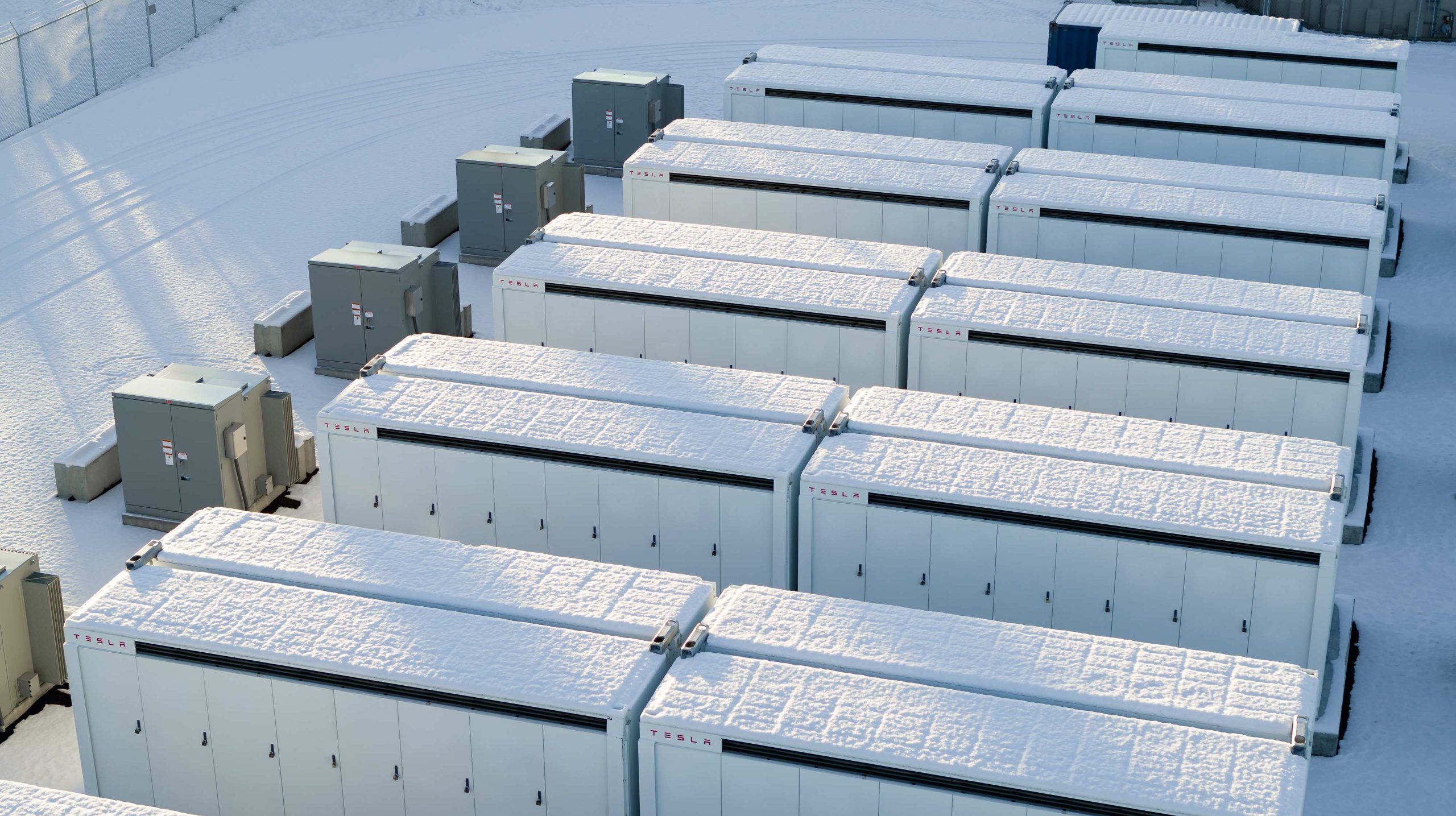
Tesla Energy recently celebrated its 10th anniversary with a dedicated video showcasing several of its milestones over the past decade.
Tesla Energy has gone far since its early days, and it is now becoming a progressively bigger part of the company.
Tesla Energy Early Days
When Elon Musk launched Tesla Energy in 2015, he noted that the business is a fundamental transformation of how the world works. To start, Tesla Energy offered the Powerwall, a 7 kWh/10 kWh home battery system, and the Powerpack, a grid-capable 100 kWh battery block that is designed for scalability. A few days after the products’ launch, Musk noted that Tesla had received 38,000 reservations for the Powerwall and 2,500 reservations for the Powerpack.
Tesla Energy’s beginnings would herald its quiet growth, with the company later announcing products like the Solar Roof tile, which is yet to be ramped, and the successor to the Powerwall, the 13.5 kWh Powerwall 2. In recent years, Tesla Energy also launched its Powerwall 3 home battery and the massive Megapack, a 3.9 MWh monster of a battery unit that has become the backbone for energy storage systems across the globe.
Key Milestones
As noted by Tesla Energy in its recent video, it has now established facilities that allow the company to manufacture 20,000 units of the Megapack every year, which should help grow the 23 GWh worth of Megapacks that have already been deployed globally.
The Powerwall remains a desirable home battery as well, with more than 850,000 units installed worldwide. These translate to 12 GWh of residential entry storage delivered to date. Just like the Megapack, Tesla is also ramping its production of the Powerwall, allowing the division to grow even more.
Tesla Energy’s Role
While Tesla Energy does not catch as much headlines as the company’s electric vehicle businesses, its contributions to the company’s bottom line have been growing. In the first quarter of 2025 alone, Tesla Energy deployed 10.4 GWh of energy storage products. Powerwall deployments also crossed 1 GWh in one quarter for the first time. As per Tesla in its Q1 2025 Update Letter, the gross margin for the Energy division has improved sequentially as well.
-

 Elon Musk2 weeks ago
Elon Musk2 weeks agoTesla investors will be shocked by Jim Cramer’s latest assessment
-

 News2 days ago
News2 days agoTesla debuts hands-free Grok AI with update 2025.26: What you need to know
-

 Elon Musk4 days ago
Elon Musk4 days agoxAI launches Grok 4 with new $300/month SuperGrok Heavy subscription
-

 Elon Musk7 days ago
Elon Musk7 days agoElon Musk confirms Grok 4 launch on July 9 with livestream event
-

 News1 week ago
News1 week agoTesla Model 3 ranks as the safest new car in Europe for 2025, per Euro NCAP tests
-

 Elon Musk2 weeks ago
Elon Musk2 weeks agoxAI’s Memphis data center receives air permit despite community criticism
-

 News4 days ago
News4 days agoTesla begins Robotaxi certification push in Arizona: report
-

 News2 weeks ago
News2 weeks agoTesla sees explosive sales growth in UK, Spain, and Netherlands in June

